CONTENTS OF
THIS SECTION |
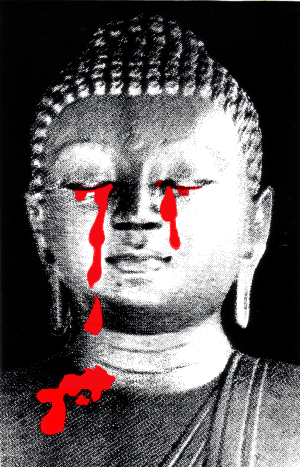
A
Picture speaks a Thousand Words |
|
Understanding the Aryan Theory Culture and Politics of Identity in Sri Lanka,
Marisa Angell |
|
Sri Lanka President Rajapaksa's Theory of
Reconciliation: Intermarriage, 7 July 2009 |
|
மகாவம்ச சிந்தனை ஒரு
வரலாற்று மீள்பார்வை - V.Thangavelu, 26 December 2008 |
|
Sri Lanka: The State Changes Face
- Jayadeva Uyangoda, 25 October 2008 |
|
Sinhala Member of European Parliament, Niranjan de Silva Deva-Aditya,
frequently wonders about
converting Tamils to Buddhism, 30 July 2008 |
|
The Mask Slips... Sri Lanka
Parliament's Buddhist War Monk, 25 March 2008 |
|
'National
Ideology' in a Buddhist Country - Kanishka
Goonewardena, 30 October 2007 |
|
�There
is a great conspiracy for Tamils from the North to link with Tamils in the
East, with the Indian Tamils in the estates and with the Tamils in Colombo
and trap the Sinhalese on the island. Add to this the 50 or is it 70 million
Tamils of South India all waiting to swim over�
-
Champika Ranawake, Cabinet Minister and JHU Member of Parliament in
Al-Jazeera television documentary �Monks of war�,
29 August 2007 |
|
On Sinhala-Buddhist
ethno-supremacy: Second Sivaram Death Anniversary: Memorial Lecture,
Laksman Gunasekera, 21 June 2007 |
|
States of Mind and
States of History: The Future in Sri Lanka Can Be Decentered
- Dr.Roshan de Silva Wijeratne, 2006 "In the classical Theravada polities of Sri Lanka
and South East Asia, the Sangha was able to develop an institutional
relationship with society and was able to actively transform that
social order. In Sri Lanka this relationship combined with the way
in which the Pali Chronicles, principally the Mahavamsa (The
Great Chronicle of Lanka) associated the island with the Sinhalese
and Buddhism as Sinhadipa and dhammadipa (the island
of the Sinhalese and Buddhism respectively) have combined to construct a
discursive frame within which the Sangha imagines its role in Sinhalese
society as guarantor of the Sinhalese Buddhist nation.."
more |
|
The Only Practical Solution
is Genocide of Tamils - D Kannangara, 7 August 2006 |
|
Reflections on the
Buddha and the myth of the Sinhala Buddhist origin
- Dr. Alvappillai Veluppillai, 9 July 2006 |
The Sangha & its Relationship to the Peace Process
in Sri Lanka
A Report for the Norwegian Ministry of Foreign Affairs, 2005 |
|
Buddhist Monks and Ethnic Politics: A War Zone in an Island Paradise
- Prof. H.L.Seneviratne, 2001 with front note by Sachi Sri Kantha |
| Buddhism Betrayed? - Religion, Politics &
Violence in Sri Lanka - S.J.Tambiah |
|
Sinhala Nationalism in Namo Namo Matha
- 'National' Anthem? What 'National' Anthem? - June 2003 |
|
Buddha’s Statues - Symbol of Sinhalese Hegemony,
A.Thangavelu, 31 May 2005 |
|
புத்தரும், சிங்களப்
பௌத்தர்களும்
- Buddha and Sinhalese Buddhists - Sanmugam Sabesan, 24 June 2005 “ If Jayewardene was a true Buddhist, I would not be carrying a
gun”
– Tamil Eelam National Leader Mr. V.
Pirapaharan |
| Sinhala Buddhist Fundamentalism & the
Destruction of Hindu Temples in Tamil Eelam and Sri Lanka - M.Neiminathan,
2000 |
|
Three Christian
Churches attacked by Sinhala Mobs led by Buddhist Monks, May 2006 |
|
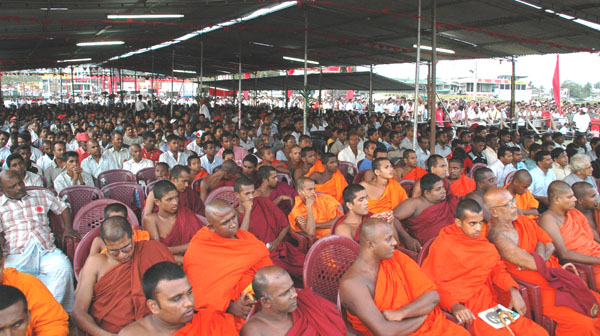
JVP
threatens to quit ruling coalition over Joint Mechanism for Tsunami Aid,
June 2005 |

Monks
Protest Against Tsunami Aid Deal, June 2005 |
|
Sinhala Buddhist Vote � Road to Independence from
Christian Domination, 2004 |
|
Conference
on 'Buddhism and Conflict in Sri Lanka - Journal
of Buddhist Ethics, 2003 |
|
A Buddhist analysis of The Ethnic Conflict - Venerable
Athureliye Rathana, 2003 "..In any country, there is a
dominant national strain. The
main community living in this
island are the Sinhalese. Their civilisation and unbroken history has been
clearly and unambiguously chronicled...It was only the Sinhalese who fought
the British in the name of their civilisational heritage.... The incidents
of 1958, 1983 etc. were tragic. They were the result of outpouring rage. For
the most part they were not
organised attacks... The real victims of ethnic conflict are in fact the
Sinhalese..." |
|
Monks demonstrate demanding consultation with Maha Sangha,
23 March 2003 |
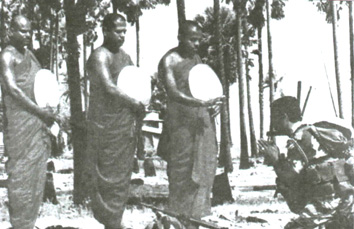 |
| Sri
Lanka monk vows to recruit 20000 soldiers, 2000 |
|
Meeting of Sinhala 'Ethnonationalists' in Stockholm -
Report by Peter Schallk, 2000 |
|
Monks and soldiers trod war road together, September
1999 |
|
Sinhala Commission - Interim Report
on the Government's Proposals for Constitutional Reform, 1997
|
|
Obstacles to Peace: Political Buddhism, Ana Pararajasingham, 1996 |
|
Buddhaputra and Bhumiputra? Dilemmas of Modern Sinhala Buddhist Monks in
Relation to Ethnic and Political Conflict by
Sarath Amunugama, 1992 |
|
Sinhala Buddhist Fundamentalism in
Marxist Garb...The Gospel - According to Rohana Wijeweera and the
Jathika Vimukthi Peramuna (JVP), 1986 ".. it is wrong to say
that there exists in Sri Lanka either a Sinhala nation or a Tamil
nation. Marxism-Leninism does not accept this. What exists is a
Sinhala nationality, a Tamil nationality, a Moslem nationality and
only a Sri Lanka nation... The proletariat opposes the
establishment of a federal system as a form of decentralization. The
north and the east cannot be one autonomous region...It is equally reactionary
to consider the north and east as the traditional homelands of the
Tamil nationality.." |
| Sinhala Buddhist Chauvinism
& the Buddhist Clergy - Brian Senewiratne, 1988 |
|
Nadesan Satyendra |
| Multi Ethnic Plural Society,1992 |
| Peace with Justice,
1992 |
| Ethnic Problem? What Ethnic Problem!,
1993 |
| Multi Ethnic Plural Society,
1993 |
| The Talkative Brigade,
1993 |
| D.B.(What ethnic problem?) Wijetunga,
1993 |
| President Wijetunga's Tamil bashing,
1994 |
| Sinhala chauvinism bears its fangs,
1994 |
Related Offsite Links |
| Buddhist Monks and Politics in Sri
Lanka - James J. Hughes |
Buddhist
Fundamentalism and Minority Identities in Sri Lanka
Eds., Tessa J. Bartholomeusz and Chandra R. De Silva,1998 |
|
Unholy Economics - Puthu Sivaguru
"..Sinhala Buddhist fundamentalism comes in all shapes and sizes. Chauvinist
ideology is part and parcel of everyday political life in Sri Lanka. The
country�s politicians preach their divisive rhetoric, the state�s military
machine turns the lethal words into deadly bullets and the island�s media
faithfully recounts racist dogma.." |
|
|
SINHALA
BUDDHIST ETHNO nationalism
- masquerading as Sri Lankan 'multi - ethnic civic nationalism'
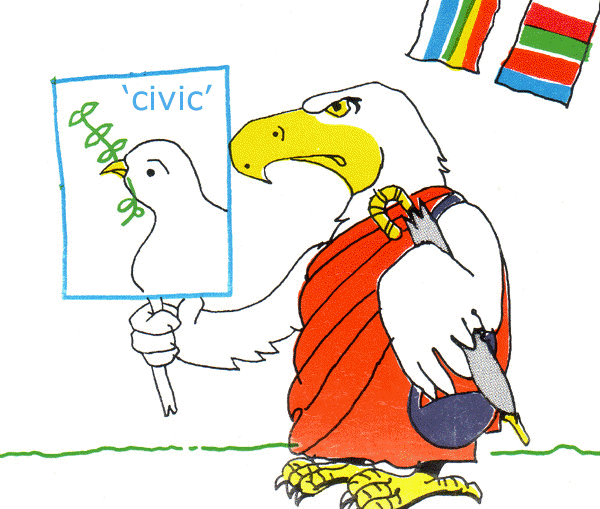
"...In the Sinhala language, the words for nation, race and people
are practically synonymous, and a
multiethnic or multicommunal
nation or state is incomprehensible to the popular mind. The
emphasis
on Sri Lanka as the land of the Sinhala Buddhists carried an emotional popular appeal,
compared with which the concept of a multiethnic polity was a meaningless
abstraction..." [Sinhala Historian K. M. de Silva in Religion, Nationalism and
the State, USF Monographs in Religion and Public Policy, No.1 (Tampa, FLA: University of
South Florida 1986) at p31 quoted by David Little in Religion and Self Determination in
Self Determination - International Perspectives, MacMillan Press, 1996]
�The
central place of Buddhism in the constitution of the Singhalese
territorial relation of a nation goes back to the Sinhalese histories of
the fourth and fifth centuries of the Christian era, the Dipavamsa and
the Mahavamsa. There one finds the myth of the visit of the Buddha to
Sri Lanka, during which he freed the Island of its original supernatural
and evil inhabitants, the Yakkas. As a result the Buddha had
sanctified the entire island transforming it into a Buddhist
territory. These histories thus asserted a territorial relation between
Sinhalese and Buddhism, the stability of which was derived from a
perceived order of the universe, that is, the actions of the Buddha. The
reaffirmation of that relation may be observed to-day in the shrines
throughout the island at Mahiyangana, where the supposed collarbone of
the Buddha is kept, at Mount Samantakuta, where the Buddha�s supposed
fossilized footprint may be seen and the most important one at Kandy,
supposedly containing the relic of the Buddha�s tooth." Stephen
Grossly, Professor of Philosophy and Religion, Clemson University on The
primordial, kinship and nationality�. �When is the Nation?� Edited by
Atsuko Ichijo and Gordana Uzelac Routledge (2005) p 68
During the past several decades, Sinhala Buddhist
Ethno Nationalism (masquerading as Sri Lankan 'Civic
Nationalism') has not been backward in giving expression to its views on the role of
Buddhism in Sri Lanka's body politic. Some of the statements by Sinhala Buddhist political
leaders and monks are set out below. And often, their words have been matched by
their deeds.
And, as
always, the record
speaks...
|
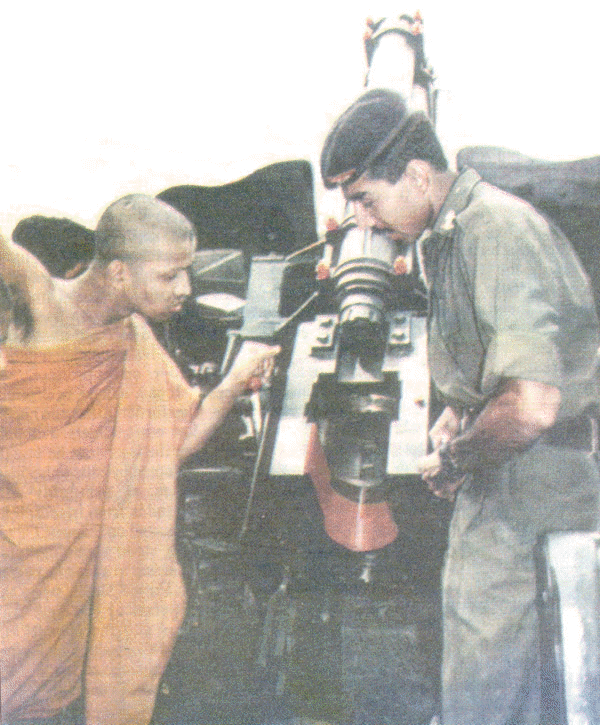
Buddhist Monk inspects Sri Lanka artillery
at the war front in 1998
|
|
 The Gospel according to
Anagarika Dharmapala
The Gospel according to
Anagarika Dharmapala |
Anagarika Dharmapala was born as
David Hewavitarana in 1864, and received his early education at Christian schools
(not unlike Arumuga Navalar). In 1891 he founded the Maha Bodhi Society to spread Buddhism
throughout the world. Dharmapala published the Mahabodhi Journal and the Sinhala
Bauddhaya in the 1910s and his virulent attacks on the Moors and Tamils led to
his internment in Calcutta by the British in 1915. He died in December 1933 aged
69.
From
Return to Righteousness: A Collection of Speeches, Essays, and Letters of the
Anagarika Dharmapala, Guruge. ed.,Colombo, Government Press, 1965:
"In the year 237 B.C. the Tamil invader Elala,
usurped the Sinhalese throne. But for several years anterior to that event there had been
a suspension of religious activities in the northern part of the island. The Tamils,
fiercely antagonistic to Buddhism, committed acts of vandalism in the sacred city of
Anuradhapura, and, for a time, there was none to deter them.
At this crisis there arose a wonderful Prince, whose
father was then reigning in Southern Ceylon. He was in his previous birth a young Bhikku
(Buddhist monk, who, when dying, was solicited by the queen to be re-born in her womb.
Particulars of this phenomenal birth are given in the Mahavansa, Chapter 22.
This young prince, Gamini Abhaya, (also known as
Dutugemenu) after he had reached maturity, made war upon the usurper, Elala. After a
series of pitched battles, the Sinhalese prince defeated Elala in single combat and slew
him on the battlefield. Then began the building of magnificent temples, dagobas
(monuments), by the conqueror, who, reducing Lanka (Ceylon) under one rule, became king.
From the world renowned ruins of these dagobas at Anuradhapura an idea of their original
splendour may be obtained.
The war that Gamini Abhaya waged with Elala was so a
religious character and he made it known by a solemn proclamation that "this
enterprise of mine is not for the purpose of acquiring the pomp and advantages of royalty.
This undertaking has always had for its object the re-establishment of the religion of the
supreme Buddha. By the truth of this declaration may the arms and equipment of my army in
the hour of battle flash, as if emitting the rays of the sun" (Mahavansa, chap. 25).
It is said that one day when, after his victorious
conquest the king was reflecting with dismay on the recollection of numerable lives
sacrificed in the attainment of his end, eight holy saints (termed Arahats) came to him
miraculously and administered spiritual comfort.
And the king said, "Lords what peace of mind can
there be left to me, when I have been the means of destroying great armies?" And the
saints answered "Supreme of men, from the commission of
that act there will be no impediment in the road to salvation.
Herein no more than two human beings have been sacrificed; the rest are heretics and
sinners, who are on a par with wild beasts. And as thou wilt cause the religion of
Buddha to shine forth in great splendour, on that account, O ruler of men, subdue thy
mental affliction!" (Mahavansa, chap, 25). Thus was the king consoled.
It was always a custom with the Sinhalese kings
when engaged in wars to take with them the "sons of Buddha" evidently to show
that the wars were conducted in a spirit of religion. To these rulers nothing appeared more supreme than this religion,
which was called the "religion of the conqueror", and was thus completely
identified with the racial individuality of the people....
1. We Sinhalese should remember that our ancestors came
from Lada, a territory between Bengal and Kalinga about 2,400 years ago, and that they
settled down in that part of the land now known as Anuradhapura......
2. When the ancestors of the present holders of our
beloved island were running naked in the forest of Britain with their bodies painted, and
later on when their ancestors had gone under the imperial rue of Rome, and some of them
were being sold as slaves in the market place of Rome, our ancestors were already enjoying
the fruits of the glorious and peaceful civilisation whose seeds were sown by the scions
of the Sakya house 540 B.C........
3. Tamils, Cochins, Hambankarayas
are employed in large numbers to the prejudice of the people of the island - sons of the
soil, who contribute the largest share........
4. About two years ago the Buddhists of Gampola carried a
procession from the temple to a certain place, and on the way the Muhammedans objected to
the procession passing by their temple or mosque with music; without music the Buddhist
procession was incomplete. The police prohibited the procession to pass the place. The
Buddhists had to turn back. The Muhammedans were not allowed to become permanent residents
in Ceylon in the Dutch period. They were allowed to permanently reside after the island
went under British rule.....................
5. Buddhism was the religion of the
state in Ceylon like the Church of England in the British Isles......
6. The Muhammedans, an alien people, who in the early part
of the nineteenth century were common traders, by Shylockian methods became prosperous
like the Jews. The Sinhalese, sons of the soil, whose ancestors from 2358 years had shed
rivers of blood to keep the country free from alien invaders, who had constructed gigantic
tanks to irrigate millions of acres, who had built the most artistic temples which have
today become the admiration of the antiquarian and scholar, today they are in the eyes of
the British only vagabonds..........
7. The alien South Indian Muhammedan comes to Ceylon, sees
the neglected illiterate villagers without any experience in trade, without any knowledge
of any kind of technical industry and isolated from the whole of Asia on account of his
language, religion and race, and the result is the Muhammedan thrives and the son of the
soil goes to the wall.......
8. But behind all this present neglect and land alienation
law the Sinhalese villager can never forget his religion. It is in
his blood. He has ancient traditions going back to several thousands of years, and
he has his history in the Maha Vansa, Dipa Vansa, Bodhi Vansa, Thupa Vansa, Datha Vansa,
Sattharmalankara, & c., and he deplores his wretched lot........
9. What the German is to the Britisher that the
Muharnmedan is to the Sinhalese. He is an alien to the Sinhalese by religion, race and
language. He traces his origin to Arabia, whilst the Sinhalese traces his origin to India
and to Aryan sources........
10.To the Sinhalese, without
Buddhism death is preferable. The British officials may shoot, hang, quarter,
imprison or to do anything to the Sinhalese, but there will always be bad blood between
the Moors and the Sinhalese. The peaceful Sinhalese have at last shown that they can no
longer bear the insults of the alien. The whole nation in one day have risen against the
Moor people.......
11. The British officials are not experienced and are
rather haughty. It is good to make them, when they arrive, to study the Maha Vansa, the
history of the island. Two and a half millions of people of the
Aryan
origin with a most noble religion, with noble traditions should not be treated as
upstarts.
12 Brahmanism is only for the three twice-born castes. The
Brahmins were proud of their mantras. The Brahmin rishis were great in their selfishness.
They had spiritual power even to frighten the gods; they cursed the later when they were
angry. It said that the rishis Durbhasa and Bhrigu cursed both Vishnu and Shiva. The rishi
Gautama cursed Indra. The Brahmin rishis organised the caste system vesting all power in
the Brahmins. They organised animal sacrifices. They drank wine, ate beef and took women
from the other three castes. It was their privilege. They made laws prohibiting the three
castes from taking Brahmin women. They laid down the rule that the issue of a Brahmin
women by a non-Brahmin husband is to be recognised as a Chandala......
13. The Bhikkhu Sangha became a universal brotherhood, and
the refuge of the high and the low. All Asia heard the law of compassion, the religion of
wisdom was preached to all, and the Dhamma of Karuna and Pragna was accepted by men and
Gods. Jehovah, Allah, Vishnu, Shiva, Kali, Durga, Jesus were names not yet heard in the
civilised world. The European races with the exception of Romans and Greeks were then in a
state of Barbaric paganism. The ancestors of the British were then living naked in the
forest. The Nordic races were still savages........
14. The destructive hordes of Islam had then not been
born. Buddhism was then flourishing in Gandahar, Afghanistan, Kabul Valley and Turkistan.
Two centuries later a new factor came into existence in India which helped to destroy the
individuality of the Buddha Dharma. Kumarila began to preach his new doctrine which
weakened the power of the Bhikkus. His successor was the Malabar Brahmin Sankara. Driven
out from his native land, young Sankara came to Jubbulpore and was admitted to a monastery
where he learnt Buddhism. Having studied the Upanishads, he gave a new interpretation to
the latter. He poured new wine into old bottles....................
15. Islam, Brahmanical ritualism and Christianity are the
three forces that are at work today in India. Brahmans through sheer selfishness rejected
the noble Aryan Dharma from its native soil and India fell.
Brahmanism is only for the high caste. Islam and Christianity are both destructive.......
16. Brahmanism, Christianity and Islam lack the spirit of
compassion. The basis of Buddha's Dharma are Ahimsa, Karuna and Pragna. These are the
ethics needed......
17. We call on every Sinhalese Buddhist who loves his
religion to contribute whatever he or she can to this fund. The Britishers are giving us
opium, ganja, whisky and other alcoholic poisons and are introducing every kind of
abominable vice that is helping to undermine the vitality of our people. We, on our part,
should with a loving heart, give the Britishers the ennobling and purifying faith of our
Tathagato.
18 The Sinhalese people are between the deep sea and the
devil. They have either to accept Christianity or become Moslems.
19. Buddhism was not the only religion that suffered
persecution at the hands of the Muhammedans. The whole of Zoroastrian literature was swept
off and the whole religion effaced out of existence in Persia. The destruction of the
magnificent collection of books in the Alexandrian library; the extirpation of Christians
in Alexandria, Asia minor and Turkey all-these fiendish acts were committed by the
fanatics of Islam, who loved to dwell in darkness and ignorance, and who have made
"The sun like blood, the earth a tomb,
The tomb a hell, and hell itself a murkier gloom"
|
 D.S. Senanayake,
Sinhala Leader of the Ceylon State Council (and later the island's first Prime Minister in
1948) on 31 July 1937:
D.S. Senanayake,
Sinhala Leader of the Ceylon State Council (and later the island's first Prime Minister in
1948) on 31 July 1937: |
"We must realise that the Sinhalese
are the rightful sons of this fair
country, and that we must organise ourselves into a determined body and even risk our
lives in doing it service. The minorities choose to believe that we are not trustworthy.
That is because we, Sinhalese, have been so tolerant and so just.
We, Sinhalese, must become conscious of our birthright."
|
 Ven.
Walpola Rahula Thero, later Vice Chancellor of the Sri Lanka Vidyalankara University
(Monks and Politics -1946):
Ven.
Walpola Rahula Thero, later Vice Chancellor of the Sri Lanka Vidyalankara University
(Monks and Politics -1946): |
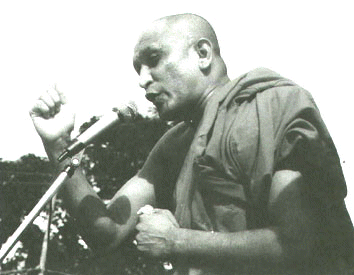 We believe that politics today embraces all fields of
human activity directed towards the public weal. No one will dispute that the work for the
promotion of the religion is the duty of the bhikkhu. It is clear that the welfare of the
religion depends on the welfare of the people who profess that religion. We believe that politics today embraces all fields of
human activity directed towards the public weal. No one will dispute that the work for the
promotion of the religion is the duty of the bhikkhu. It is clear that the welfare of the
religion depends on the welfare of the people who profess that religion.
History bears evidence to the fact that whenever the
Sinhala nation - which was essentially a Buddhist nation - was prosperous, Buddhism also
flourished.
We, therefore, declare that it is nothing but fitting for
bhikkus to identify themselves with activities conducive to the welfare of our people -
whether these activities be labelled politics or not - as long as they do not constitute
an impediment to the religious life of a bhikku.
|

Buddhist Monks blessing Sinhala soldiers at the war front
in the Jaffna Peninsula in the Tamil homeland |
We cannot forget that from the earliest days the Sinhala
monks, while leading the lives of bhikkhus, were in the forefront of movements for the
progress of their nation, their county, and their religion.
Even today bhikkhus by being engaged actively in
education, rural reconstruction' anti-crime campaigns, relief work, temperance work,
social work and such other activities, are taking part in politics, whether they are aware
of it or not. We do not believe that it is wrong for bhikkhus to participate in these
activities.
In ancient days, according to the records of history, the
welfare of the nation and the welfare of the religion were regarded as synonymous by
the laity as well as by the Sangha. The divorce of religion from the nation was an idea
introduced onto the minds of the Sinhalese by invaders from the West, who belonged to an
alien faith. It was a convenient instrument of astute policy to enable them to keep the
people in subjugation in order to rule the country as they pleased.
It was in their own interests, and not for the welfare of
the people, that these foreign invaders attempted to create a gulf between the bhikkhus
and the laity - a policy which they implemented with diplomatic cunning. We should not
follow their example, and should not attempt to withdraw bhikkus from society. Such
conduct would assuredly be deplorable act of injustice, committed against our nation, our
country, and our religion........
|
 D.C. Wijewardena
(Revolt
in the Temple: Composed to Commemmorate 2500 Years of the Land, the Race and the Faith,
1953)
D.C. Wijewardena
(Revolt
in the Temple: Composed to Commemmorate 2500 Years of the Land, the Race and the Faith,
1953) |
"The history of Sri Lanka is the
history of the Sinhalese race... The Sinhalese people were entrusted 2500 years ago, with
a great and noble charge, the preservation... of Buddhism.. in 1956 will occur the unique
three fold event - the completion of 2500 years of Ceylon’s history, of the tie of
Sinhalese and Buddhism...
The birth of the Sinhalese race would thus seem to have been not a mere
chance, not an accidental occurrence, but a predestined event of high import and purpose. The nation seemed designed, as it were, from its
rise, primarily to carry aloft for fifty centuries the torch that was lit by the great
World-Mentor (the Buddha) twenty five centuries ago...... The Sinhalese Empire,
stretching from the Maldive Islands to the Shan States in the12th century, was the outcome
of Sinhalese reaction to unprovoked foreign aggression and wanton insult to the Sinhalese
name. ... In less than four generations, barren wastes were turned into fruitfulness by
thousands of immigrants from Northern India... Most of these people were Sinhalese in
heart and mind before they left their motherland... And Aryan
culture was bodily transported to create and enrich the virgin soil of Lanka.
These Aryans dotted the country with settlements of farmers.."
|
|
 Rodaya (Wheel) in the
run up to the 1956 General Elections - 25 February 1956
Rodaya (Wheel) in the
run up to the 1956 General Elections - 25 February 1956 |
"The bhikkhus should be present in every polling
booth. They should explain to the people how to use the vote correctly .... A Government
that will work for the country, religion and its culture should be elected. The end of the
Sasana will not be very long if we remain in silence .... We appeal to Bhikkhus to visit
every Buddhist home and to direct them on the right path. You may have to confront many
difficulties. But be ready to sacrifice your life to restore a
Buddhist Ceylon."
|
J.R.Jayawardene,
Sinhala Buddhist Opposition Leader,
later President of Sri Lanka
- reported in Sri Lanka Tribune, 30th August 1957 |
|
"...The time has come for the whole Sinhala race
which has existed for 2500 years, jealously safeguarding their language and religion, to
fight without giving any quarter to save their birthright... I will lead the
campaign..." |
|
W.J.M. Lokubandara, Sinhala Buddhist M.P.
- in Sri Lanka's Parliament, July 1981 |
"If there is discrimination in this land which is not their (Tamil) homeland, then
why try to stay here.Why not go back home (India) where there would
be no discrimination. There are your kovils and Gods.There you have your culture,
education, universities etc. There you are masters of your own fate.... It
would be advisable for the Tamils not to disturb the sleeping Sinhala brother. Everybody
knows that lions when disturbed are not peaceful."
|
Wimala Kannangara M.P., Sinhala Buddhist
Minister for Rural Development
- in Sri Lanka's Parliament, July 1981
|
"If we are governing, we must govern. If we are ruling, we must rule. Do not give
into the minorities. We are born as Sinhalese and as Buddhists in
this country. Though we are in a majority,
we have been
surrendering to the minority community for four years. Let us rule as a majority
community".
|
|
D.M. Chandrapala, Sinhala Buddhist M.P. for
Kundasale - in Sri Lanka's Parliament, July 1981 |
"Now, Sir... what should we do to this so called leader of the Tamils? If I were
given the power, I would tie him to the nearest concrete post in
this building and horsewhip him till I raise him to his wits. Thereafter let
anybody do anything he likes - throw him into the Beire (lake) or into the sea,
because he will be so mutilated that I do not think there
will be life in him. That is war."
|
|
G.V.Punchinilame, Sinhala Buddhist M.P. for
Ratnapura - in Sri Lanka's Parliament, July 1981 |
"Since yesterday morning, we have heard in this honourable House about the various
types of punishment that should be meted out to them (Tamil Parliamentary leaders).
The MP for Panadura (Dr Neville Fernando) said there
was a
punishment during the time of the Sinhalese kings, namely, two arecanut posts are erected,
the two posts are then drawn toward each other with a rope, then tie each of the feet of
the offender to each post and then cut the rope which result in the tearing apart the
body. These people also should be punished in the same way..
...some members suggested that they should be put to death on the stake; some other
members said that their passports should be confiscated; still other members said that
they should be stood at the Galle Face Green and shot. The people of
this country want and the government is prepared to inflict these punishments on these
people."
|
 Cyril Mathew, a Senior
Sinhala Buddhist Minister in President J.R.Jayawardene's Cabinet, who was also present in Jaffna on the day that the
Jaffna Public Library was burnt - in a leaflet
published in 1982, an year before
Genocide'83:
Cyril Mathew, a Senior
Sinhala Buddhist Minister in President J.R.Jayawardene's Cabinet, who was also present in Jaffna on the day that the
Jaffna Public Library was burnt - in a leaflet
published in 1982, an year before
Genocide'83: |
"The link between the Sinhala race and Buddhism is so
close and inseparable that it had led to the maxim, "There is
no Buddhism without the Sinhalese and no Sinhalese without Buddhism." This is
an undeniable fact.
The literature of the Sinhalese is Buddhist literature.
The history of the Sinhalese is the history of Buddhism. The language of the Sinhalese is
enriched by the doctrine of the Buddha. The era of the Sinhalese is the Buddha Era. The
culture of the Sinhalese is Buddhist culture.
The flag
of the Sinhalese is the Sinhala Buddhist flag."........
`'With the establishment of Buddhism, the Sinhala culture
and civilisation took on a new orientation. The life of the Sinhalese began to he guided
by Buddhism. Their very creation, every work,was full of the influences of Buddhism.
Villages and temples, homes and palaces, all were refined by the spirit of the Buddhist
teachings. From the north to the south and from the west to the east, the entire length
and breadth of the Tri- Sinhala kingdom had only one culture; that was the Sinhala
Buddhist culture Yet from a few years ago, there has been an organised movement of
anti-Sinhala, anti Buddhist barbarians to destroy our invaluable archaeological ruins and
Buddhist shines."........
"We all know that in every civilised society the
civilisation has grown by basing itself on the cultural values and the religious ideology
of the majority population of those countries. Sri Lanka is known as Sinhala.
It is a Buddhist country. Nobody can deny this fact. No rulers can forget
this fact. If they do I do not think such a ruler will last for more than twenty four
hours."
"Even though
Prime Minister Bandaranayake, and former
Prime Minister Dudley Senanayake were so
intimidated by the Tamil parties that they were prepared to grant them a Tamil state,
under the pretext of setting up district councils or regional councils, the Sinhalese
forces that rose up in protest were so strong that one was forced to tear up the
agreement, while the other had to rescind the legislation."..........
|
|
J.R.Jayawardene,
Sinhala Buddhist President of Sri Lanka - Daily Telegraph, 11th July 1983 |
"I am not worried about the opinion of the
Tamil people... now we cannot think of them,
not about their
lives or their opinion... the more you put pressure in the north, the happier the
Sinhala people will be here... Really if I starve the Tamils out, the Sinhala people will
be happy."
|
|
Gamini Dissanayake,
Senior Sinhala Buddhist Minister in President J.R.Jayawardene's Cabinet
(later Presidential Candidate in 1995), addressing members of a Tamil Estate
Workers Trade Union in the aftermath of
Genocide'83 - October
1983 |
"Who attacked you?
Sinhalese.
Who protected you? Sinhalese. It is we
who can attack and protect you. They are bringing an army from India. It will take
fourteen hours to come from India. In fourteen minutes the blood of every Tamil in the
country can be sacrificed to the land, by us. It is not written on anyone's forehead that
he is an Indian Tamil or a Jaffna Tamil, a Batticaloa Tamil or up country Tamil' Hindu
Tamil or Christian Tamil. All are Tamils.
We have decided to colonise
four districts including Mannar with Sinhalese people by destroying forests. A
majority of Sinhalese will be settled there. If you like you also can migrate there."
|
|
Ven DimbulgalaThero,
August 1984 |
'You are assembled here today,
not only to get a piece of land for you to live on, but for more lofty purpose. This
country is going through her worst period in history. We are being threatened from all
sides by the separatists. What the separatists want is land. A contiguous block of land
which they propose to call Eelam.
You are going to break
that contiguity.......Remember your eternal hero, King
Dutagemunu. We are going on a holy mission. Now let us go on our journey.'
|
|
Ven. Madihe Pannaseeha Mahanayaka Thera
- Sri Lanka Sunday Times on 29 December 1991
|
It is true that with the coming into power of the "people’s" government
of the SLFP in 1956, many of the privileges enjoyed
by our Tamil brethren eroded. This has been interpreted as "discrimination"
against them. Anybody, who had spoken and who now speaks for the rights of the majority
community and against allowing any more privileges to the minority not available to the
majority, are dumped as communalists and Sinhala chauvinists. No one should be carried
away and frightened by these slogans....
|
|
Ven.
Galaboda Gnanassara Thera, the Chief Incumbent of Gangaramaya
- in the Sinhala owned Sri Lanka Sunday Times, 29 December 1991 |
" The majority in this country are
Sinhalese. Without the consent of the majority no one can
come into power"
|
|
Sinhala Buddhist Sri Lanka President
D.B.Wijetunga
(in Sinhala owned Sri Lanka Island, 3 February 1994)
|
"Our children should be able to claim that this country is the Sinhalese land
(Sinhala Deshaya). There are no races according to Buddhism, but every country has a
majority race. However much I try I can't become the Prime Minister of England. Neither
can I be the leader of Japan, India or even Tamil Nadu. They have their majority races. In
our country the majority (Sinhala) race is divided because of elections.
The major (Sinhala) political parties trust minority races and
pledge to offer them everything, whether it is good or bad... Thousands (of Tamils on
the plantations) were given citizenship due to this
bondage."
|
 Ven.
Walpola Rahula Thero, Vice Chancellor, Sri Lanka Vidyalankara University
("The
Unsung Forces of the '56 Victory" in Sinhala owned Sri Lanka Sunday Times,25
September 1994)
Ven.
Walpola Rahula Thero, Vice Chancellor, Sri Lanka Vidyalankara University
("The
Unsung Forces of the '56 Victory" in Sinhala owned Sri Lanka Sunday Times,25
September 1994) |
The main task of the new Balavegaya or the movement was to
start Buddha Sasana Samithis throughout the Island, beginning from Ratnapura. The declared
motive of the Buddha Sasana Samithis I launched in 1952, was to bring about a Buddhist
renaissance all over the county by the Buddha Jayanthi year in 1956.
Though the declared motive was that, there was an
undeclared or ulterior motive behind, which was known only to Gnanaseeha Thera and Dias.
That hidden motive was to establish a true Sinhala Buddhist government in
Sri Lanka in the Buddha Jayanthi year, or the 2500th year after the passing away of
the Buddha, which was 1956 according to the Christian era. All the Buddhists, both lay and
clergy, gave their fullest support to the Buddha Sasana Samurai movement. (photo
below: Leading Buddhist monk, Ven. Maduluwave Sobitha,
President of the Sinhala Bala Mandalaya in action)
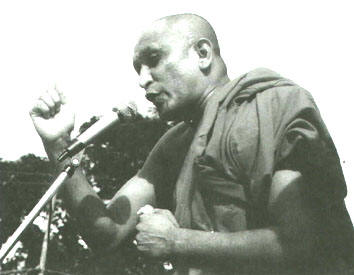
While the movement was growing by leaps and bounds, one
fine day, Gnanaseeha Thera received a message from his long-time friend S.W. R. D.
Bandaranaike, requesting the monk to meet him as early as possible.
When Gnanaseeha Thera met Bandaranaike, who was the Leader
of the Opposition, at his Rosmead Place residence, the latter said that when he went round
the country a few weeks before, he was surprised to learn that a movement called Buddha
Sasana Samithi started by Gnanaseeha Thera and N.Q. Dias gathering momentum.
After a long chat Bandaranaike said: "Hamuduruwane, I
don't have anyone to help me now. Nobody comes to see me because they all fear Kotelawala.
Only Duncan Alwis comes once a day and attends to my correspondence. I am an isolated man.
But, my only request to you is to not to forget me'?.
Gnanaseeha Thera who felt so sorry for Bandaranaike, got
up and went near him. "Don't have any fear. Be prepared to be the next Prime Minister
of this country", he told Bandaranaike and left the place.......
After the victory, when Bandaranaike and the Ministers
visited Kelaniya Raja Maha Vihara, Gnanaseeha Thera warned them in the following manner:
"You know why we went all out to defeat the previous government.
Mr. Prime Minister, don't forget the fact that we will punish you too in
the same way if you also follow the same path".
|
 David Little in Belief,
Ethnicity & Nationalism, 1995
David Little in Belief,
Ethnicity & Nationalism, 1995 |
"...The specific role of religion and
related cultural factor in the Sri Lankan conflict is clearly
significant. While nationalism is a relatively modern invention in
Sri Lanka, it nevertheless draws on and puts to use traditional
religious warrants. Sinhala Buddhist "revivalists" of the late
nineteenth and twentieth centuries have artfully manipulated ancient
legends concerning Buddha's alleged associations with Sri Lanka, as
well as the patterns of cooperation and mutual support between king
and monastery that are part of the island's history. These appeals
have done much to mobilize support for Sinhala nationalism among the
monks and laity, and to provide the movement with sacred
authority... What is most menacing about the type of religious and
ethnic nationalism that has appeared in Sri Lanka is precisely its
more or less systematic incompatibility with the right of non discrimination."
|
 Ven.
Walpola Rahula Thero Vice Chancellor, Sri Lanka Vidyalankara University
- Sinhala owned Sri Lanka Sunday Times , 5 May 1996
Ven.
Walpola Rahula Thero Vice Chancellor, Sri Lanka Vidyalankara University
- Sinhala owned Sri Lanka Sunday Times , 5 May 1996 |
"Get this straight and quote me.
Sri Lanka is a Buddhist Sinhala country. Let no one make a mistake.
Seventy percent of the country consists of Buddhists and Sinhala people. Also make this
clear that Sri Lanka is the only Buddhist Sinhala country in the world. If we don't live
here, are the LTTE and some of the Tamil Parties asking us to jump into the sea? I got angry with Mr. Premadasa because he chose to call Sri Lanka
a multi-national and multi-religious state. No. It is a Buddhist State but we show no discrimination to other races or religion.......
More than 2,000 members of the Sangha including the prelates of Asgiriya and Malwatte, had
a meeting at which I too spoke. We cannot support the devolution package It seeks to merge
the North and East otherwise the Tamils will not accept it.
|
 Official website opened by the
Sinhala Buddhist Sri Lanka government, to herald the 50th anniversary of Sri Lanka's
independence, December 1997
Official website opened by the
Sinhala Buddhist Sri Lanka government, to herald the 50th anniversary of Sri Lanka's
independence, December 1997 |
"The
history of Sri Lanka goes back to
pre-historic times with a recorded history of over 2,000 years... documented history began with the arrival of the settlers from North India (Prince Vijaya). They
introduced the use of agriculture through a rudimentary system of irrigation. They also
introduced the art of government. Of the ancient settlements, Anuradhapura grew into a
powerful kingdom under the rule of Pandukabhaya. According to traditional history he is
accepted as the founder of Anuradhapura.
During the region of King Devanampiya Tissa, a descendant of
Pandukabhaya, Buddhism was introduced in 427 B.C. by Arahat Mahinda, the son of Emperor
Asoka of India. This is an important event in Sri Lankan history as
it made the country predominantly Buddhist influencing its way of life and culture.
In the mid 2nd
century B.C. a large part of North Sri Lanka came under the
rule of an invader from South India. From the beginning of
the Christian era and up to the end of the 4th century A.D. Sri Lanka was governed by an
unbroken dynasty called Lambakarna, which paid great attention to the development of
irrigation. A great king of this dynasty King Mahasen (3rd century A.D.) who started the
construction of large 'tanks' (reservoirs) which in turn fed smaller reservoirs. Another
great 'tank' builder was Dhatusena, who was put to death by his son Kasyapa, who made
Sigiriya a royal city with his fortress capital on the summit of the rock.
As a result of invasions from
South India the Kingdom of Anuradhapura fell by the end of the 10th century A.D.
Vijayabahu I repulsed the invaders and established his capital at Polonnaruwa in the 11th
century A.D. Other great kings of Polonnaruwa were Parakrama Bahu the Great and Nissanka
Malla, both of whom adorned the city with numerous buildings of architectural
beauty...."
|
|
Sinhala Buddhist Sri Lanka President
Chandrika
Kumaratunga - television interview in South Africa, September 1998
|
"They [Tamils] are wanting a separate state – a minority community which is
not the original people of the
country..."
|
 Sinhala Buddhist Sri Lanka President
Chandrika Kumaratunga - A 'stirring' call to the Sinhala Buddhist Army
occupying the Tamil homeland - from Sri Lanka
State Controlled Sri
Lanka Daily News, 12 May 2000
Sinhala Buddhist Sri Lanka President
Chandrika Kumaratunga - A 'stirring' call to the Sinhala Buddhist Army
occupying the Tamil homeland - from Sri Lanka
State Controlled Sri
Lanka Daily News, 12 May 2000 |
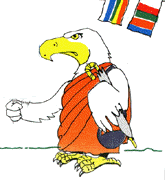 "...Throughout
history, timely heroes were born against forces which had tried to divide our nation. I
think it is due to the inspiration received form such heroes that people like you have
been born today...
Although there had been
setbacks in the past let us resolve to correct our wrongs and re-organise ourselves to
defeat the enemy. Sun Tzu, the world famous
philosopher on military strategy has said setbacks are stepping stones for future victory.
History records that even Kings Dutugemunu, Gajabahu, Vijayabahu and Parakramabahu have
suffered defeat at the hands of the enemy at some stage. But each time they faced such
setbacks, they had faced the enemy with renewed strength and achieved victory. Dear war
heroes, we too have to follow in the footsteps of
our past heroes... As Head of State. I assure you that the Government will lend you
all support and assistance to accomplish that task. Your blood is boiling to liberate your
motherland and I am confident that no one can undermine your enthusiasm and commitment...
Heroic soldiers ultimate victory will be yours." "...Throughout
history, timely heroes were born against forces which had tried to divide our nation. I
think it is due to the inspiration received form such heroes that people like you have
been born today...
Although there had been
setbacks in the past let us resolve to correct our wrongs and re-organise ourselves to
defeat the enemy. Sun Tzu, the world famous
philosopher on military strategy has said setbacks are stepping stones for future victory.
History records that even Kings Dutugemunu, Gajabahu, Vijayabahu and Parakramabahu have
suffered defeat at the hands of the enemy at some stage. But each time they faced such
setbacks, they had faced the enemy with renewed strength and achieved victory. Dear war
heroes, we too have to follow in the footsteps of
our past heroes... As Head of State. I assure you that the Government will lend you
all support and assistance to accomplish that task. Your blood is boiling to liberate your
motherland and I am confident that no one can undermine your enthusiasm and commitment...
Heroic soldiers ultimate victory will be yours."
|
|
 US Aid - Sri Lanka Democracy and Governance Assessments, May 2001
US Aid - Sri Lanka Democracy and Governance Assessments, May 2001 |
"...Based on its interviews and review of
literature, the
assessment team believes that the central Democracy and Governance problem facing Sri Lanka is: The gradual
unravelling of the Sri Lankan nation-state due to the combined
effects of
protracted ethnic-based conflict and
deteriorating democratic rights and
institutions...The team has identified five key and interrelated causes of
the DG problem Sri Lanka faces.. They are:
1) The notion of the Sri Lankan nation subscribed to by many Sinhalese –
including most of Sri Lanka’s
politically influential Buddhist monks – is based on a firmly-rooted belief
in the primacy of the
Sinhalese/Buddhist majority and its culture.
2) Elite political competition, principally between two major political
parties, fuels ethnically-based majoritarianism and is increasingly undemocratic..."
|
 A Buddhist analysis of The Ethnic Conflict - Venerable
Athureliye Rathana, 2003
A Buddhist analysis of The Ethnic Conflict - Venerable
Athureliye Rathana, 2003 |
"..In any country, there is a
dominant national strain. The
main community living in this
island are the Sinhalese. Their civilisation and unbroken history has been
clearly and unambiguously chronicled...It was only the Sinhalese who fought
the British in the name of their civilisational heritage.... The incidents
of 1958,
1983 etc. were tragic. They were the result of outpouring rage. For
the most part they were not
organised attacks... The real victims of ethnic conflict are in fact the
Sinhalese..."
|
|